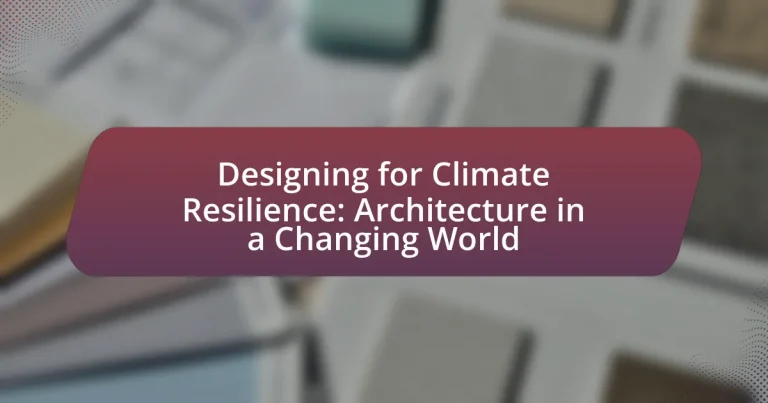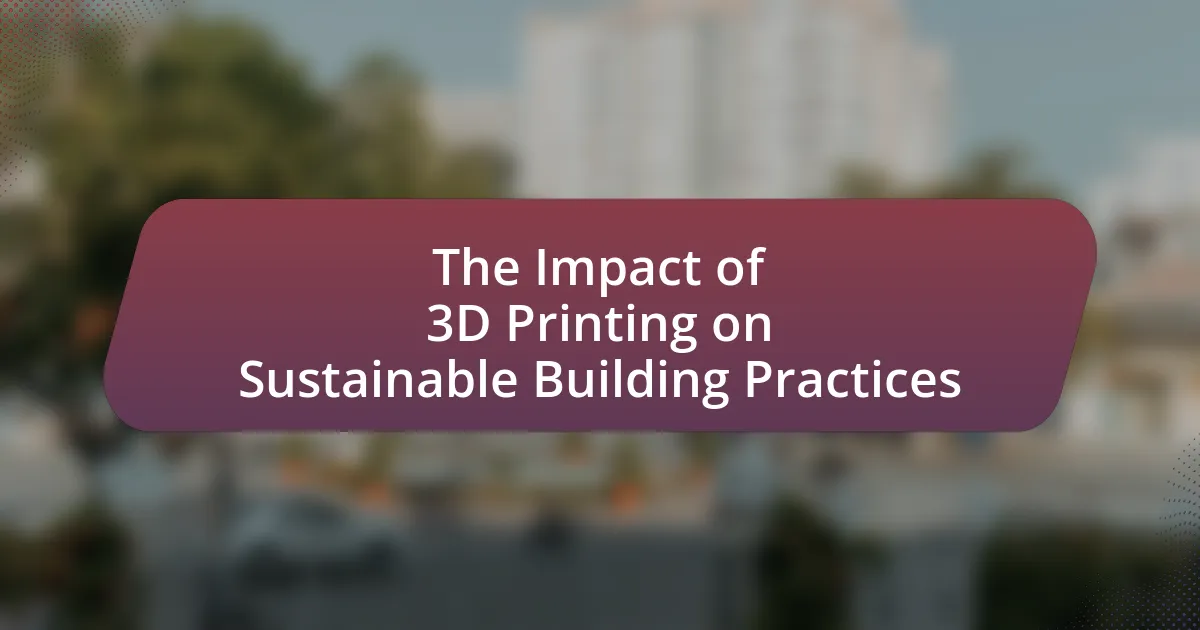Designing for climate resilience in architecture focuses on creating structures that can withstand and adapt to the effects of climate change, including extreme weather, rising sea levels, and temperature variations. The article outlines the significant impact of climate change on architectural design, emphasizing the necessity for sustainable practices and materials to enhance resilience. Key challenges faced by architects include the need for durable designs, reducing carbon emissions, and adapting to shifting environmental conditions. The article also discusses strategies for incorporating sustainable materials, the role of technology in improving building performance, and best practices for effective climate resilience, ultimately highlighting the importance of community engagement and adaptability in architectural design.
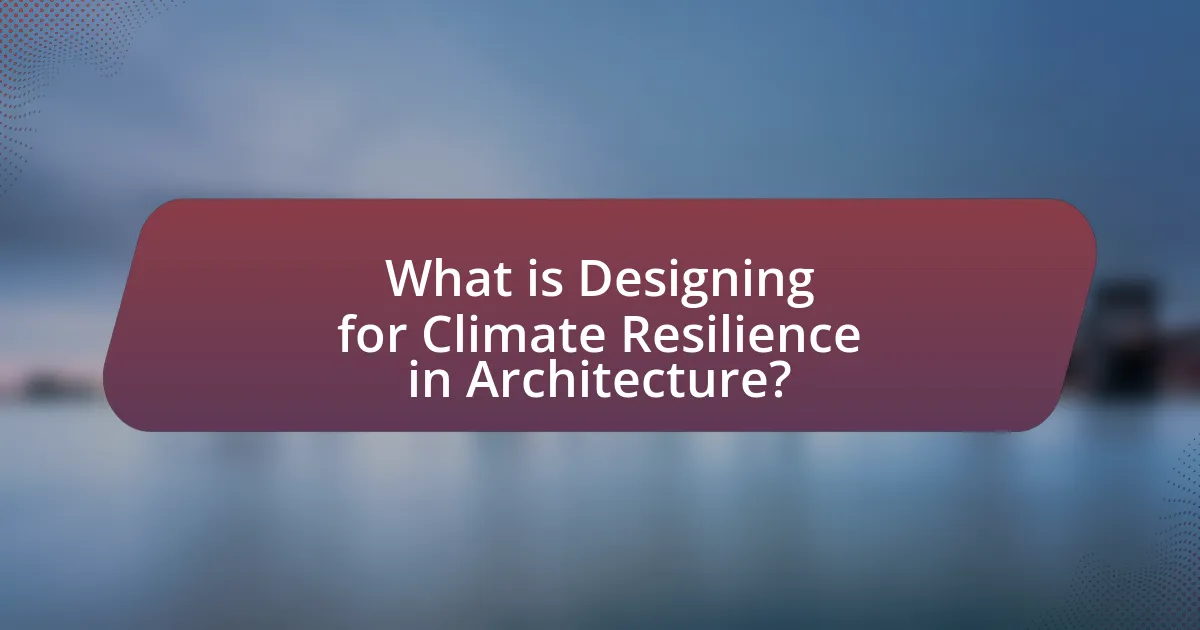
What is Designing for Climate Resilience in Architecture?
Designing for climate resilience in architecture involves creating buildings and spaces that can withstand and adapt to the impacts of climate change, such as extreme weather events, rising sea levels, and temperature fluctuations. This approach integrates sustainable practices, such as using durable materials, optimizing energy efficiency, and incorporating green infrastructure, to enhance the longevity and functionality of structures. For instance, the American Institute of Architects emphasizes that resilient design not only protects physical assets but also supports community well-being and economic stability in the face of climate challenges.
How does climate change impact architectural design?
Climate change significantly impacts architectural design by necessitating the incorporation of sustainable practices and materials to enhance resilience against extreme weather events. Architects are increasingly required to design buildings that can withstand rising temperatures, increased precipitation, and severe storms, which are all consequences of climate change. For instance, the American Institute of Architects emphasizes the need for energy-efficient designs and the use of renewable materials to reduce carbon footprints. Additionally, studies show that buildings designed with climate resilience in mind can lower energy costs by up to 30%, demonstrating the economic benefits of adapting architectural practices to address climate change.
What are the key climate-related challenges architects face?
Architects face several key climate-related challenges, including the need to design buildings that can withstand extreme weather events, reduce carbon emissions, and adapt to changing environmental conditions. Extreme weather events, such as hurricanes and floods, require architects to incorporate resilient design strategies, such as elevated structures and robust materials, to ensure safety and longevity. Additionally, the construction and operation of buildings contribute significantly to global carbon emissions; therefore, architects must prioritize energy efficiency and sustainable materials to mitigate their environmental impact. Furthermore, climate change leads to shifting temperature and precipitation patterns, necessitating adaptive designs that can respond to these changes over time. These challenges are underscored by the Intergovernmental Panel on Climate Change, which emphasizes the urgent need for the built environment to adapt to climate impacts to ensure sustainability and resilience.
How do these challenges influence design choices?
Challenges such as extreme weather events, rising sea levels, and resource scarcity significantly influence design choices in architecture aimed at climate resilience. Architects must prioritize durability and adaptability in their designs to withstand these environmental stresses. For instance, incorporating materials that are resistant to moisture and temperature fluctuations can enhance a building’s longevity. Additionally, designs often include elevated structures in flood-prone areas to mitigate the risk of water damage, as seen in coastal cities like New Orleans, where building codes have evolved in response to hurricane threats. Furthermore, sustainable practices, such as using renewable energy sources and efficient water management systems, are increasingly integrated into architectural designs to address resource scarcity and reduce carbon footprints. These adaptations reflect a proactive approach to ensuring that buildings not only survive but thrive in changing climatic conditions.
Why is climate resilience important in architecture?
Climate resilience is important in architecture because it ensures that buildings can withstand and adapt to the impacts of climate change, such as extreme weather events, rising sea levels, and temperature fluctuations. This adaptability not only protects the structural integrity and longevity of buildings but also safeguards the health and safety of occupants. For instance, according to the Intergovernmental Panel on Climate Change (IPCC), climate-related disasters have increased significantly, highlighting the need for resilient design strategies that mitigate risks and enhance sustainability. By integrating climate resilience into architectural practices, communities can reduce vulnerability, lower repair costs, and promote environmental stewardship, ultimately contributing to a more sustainable future.
What are the long-term benefits of resilient design?
The long-term benefits of resilient design include enhanced durability, reduced maintenance costs, and improved adaptability to climate change. Resilient design strategies, such as using sustainable materials and incorporating energy-efficient systems, lead to structures that withstand extreme weather events, thereby minimizing damage and repair expenses over time. For instance, buildings designed to endure flooding or high winds can significantly lower insurance premiums and increase property value. Additionally, resilient design fosters community sustainability by promoting ecological balance and reducing resource consumption, which is crucial as climate-related challenges intensify.
How does climate resilience contribute to sustainability?
Climate resilience contributes to sustainability by enabling systems to withstand and adapt to climate-related disruptions while maintaining essential functions. This adaptability reduces vulnerability to extreme weather events, thereby preserving resources and ecosystems. For instance, resilient infrastructure, such as flood-resistant buildings, minimizes damage and recovery costs, promoting long-term environmental and economic sustainability. Studies indicate that investing in climate-resilient practices can yield returns of up to four times the initial investment by reducing disaster recovery expenses and enhancing community stability.
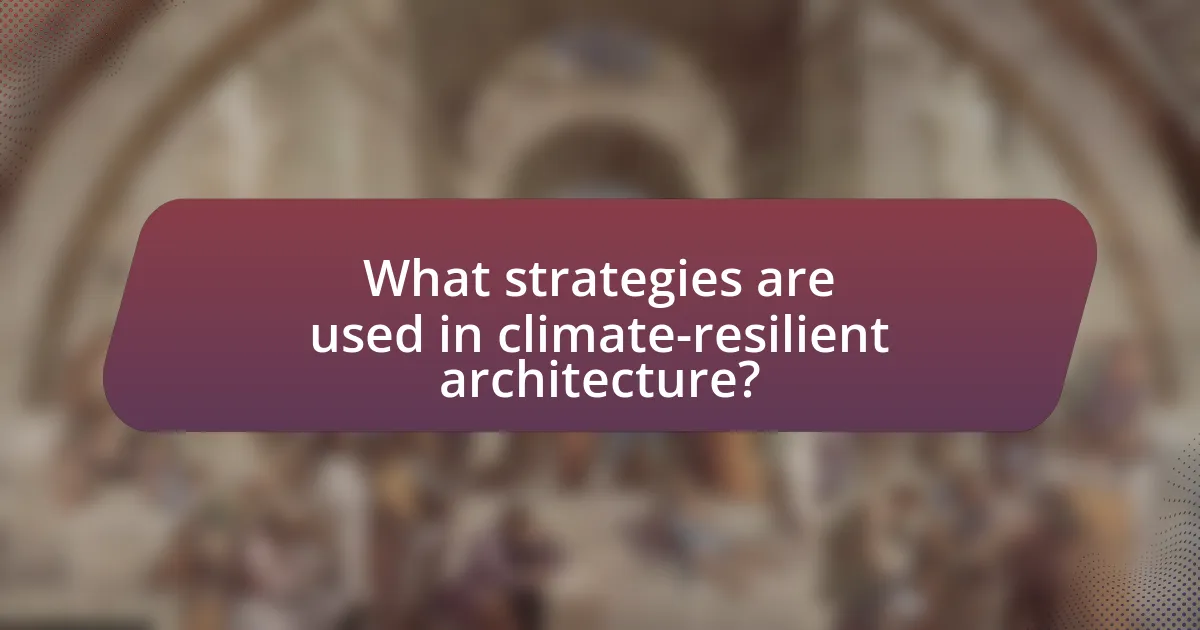
What strategies are used in climate-resilient architecture?
Climate-resilient architecture employs strategies such as passive design, sustainable materials, and adaptive reuse to mitigate the impacts of climate change. Passive design optimizes natural light and ventilation, reducing energy consumption and enhancing indoor comfort. Sustainable materials, including recycled and locally sourced options, minimize environmental impact and promote durability. Adaptive reuse involves repurposing existing structures to extend their lifespan and reduce resource consumption, aligning with principles of sustainability. These strategies collectively contribute to buildings that can withstand extreme weather events and changing environmental conditions, thereby enhancing resilience in the built environment.
How can architects incorporate sustainable materials?
Architects can incorporate sustainable materials by selecting resources that are renewable, recycled, or have low environmental impact. For instance, using bamboo, which grows rapidly and absorbs carbon dioxide, or reclaimed wood, which reduces waste and the need for new logging, exemplifies this approach. Additionally, materials like recycled steel and concrete can significantly lower the carbon footprint of a building. According to the U.S. Green Building Council, buildings that utilize sustainable materials can reduce energy consumption by up to 30%, demonstrating the effectiveness of this strategy in promoting environmental sustainability.
What types of materials are considered sustainable?
Sustainable materials include bamboo, recycled metals, reclaimed wood, and natural fibers such as hemp and jute. Bamboo is a fast-growing plant that sequesters carbon and can be harvested without killing the plant, making it a renewable resource. Recycled metals, such as aluminum and steel, reduce the need for virgin materials and lower energy consumption during production. Reclaimed wood repurposes existing timber, minimizing waste and preserving forests. Natural fibers like hemp and jute are biodegradable and require fewer pesticides and fertilizers compared to conventional crops, contributing to lower environmental impact. These materials collectively support sustainable practices in architecture and construction, aligning with climate resilience goals.
How do these materials enhance resilience?
Materials enhance resilience by providing durability and adaptability to environmental stresses. For instance, materials such as high-performance concrete and engineered wood can withstand extreme weather conditions, reducing structural damage during events like storms or floods. Research indicates that buildings constructed with these materials have a lower failure rate in adverse conditions, as evidenced by studies showing that structures using resilient materials can last up to 50% longer than those built with traditional materials in similar climates. This durability not only protects the integrity of the buildings but also ensures the safety and longevity of the occupants and infrastructure.
What role does technology play in climate-resilient design?
Technology plays a crucial role in climate-resilient design by enabling the development of innovative materials, systems, and processes that enhance the adaptability of structures to climate change impacts. For instance, advanced modeling software allows architects to simulate environmental conditions and assess the resilience of designs against extreme weather events. Additionally, smart building technologies, such as energy-efficient systems and automated climate controls, help reduce energy consumption and improve sustainability. Research indicates that incorporating these technologies can lead to a significant reduction in greenhouse gas emissions, with studies showing that buildings equipped with smart technologies can reduce energy use by up to 30%.
How can smart technologies improve building performance?
Smart technologies can improve building performance by optimizing energy efficiency, enhancing occupant comfort, and enabling predictive maintenance. For instance, smart sensors and IoT devices monitor real-time data on energy usage and environmental conditions, allowing for automated adjustments to heating, cooling, and lighting systems. According to a study by the U.S. Department of Energy, buildings equipped with smart technologies can achieve energy savings of up to 30%. Additionally, smart building management systems can analyze data trends to predict maintenance needs, reducing downtime and repair costs. This integration of technology not only leads to lower operational costs but also contributes to sustainability goals by minimizing resource consumption.
What are examples of innovative technologies in architecture?
Examples of innovative technologies in architecture include Building Information Modeling (BIM), 3D printing, and smart building systems. BIM enhances collaboration and efficiency in design and construction by creating a digital representation of physical and functional characteristics of a building. 3D printing allows for rapid prototyping and the creation of complex structures with reduced waste and cost. Smart building systems integrate IoT devices to optimize energy use, improve occupant comfort, and enhance building management. These technologies contribute to sustainable practices and climate resilience in architecture.
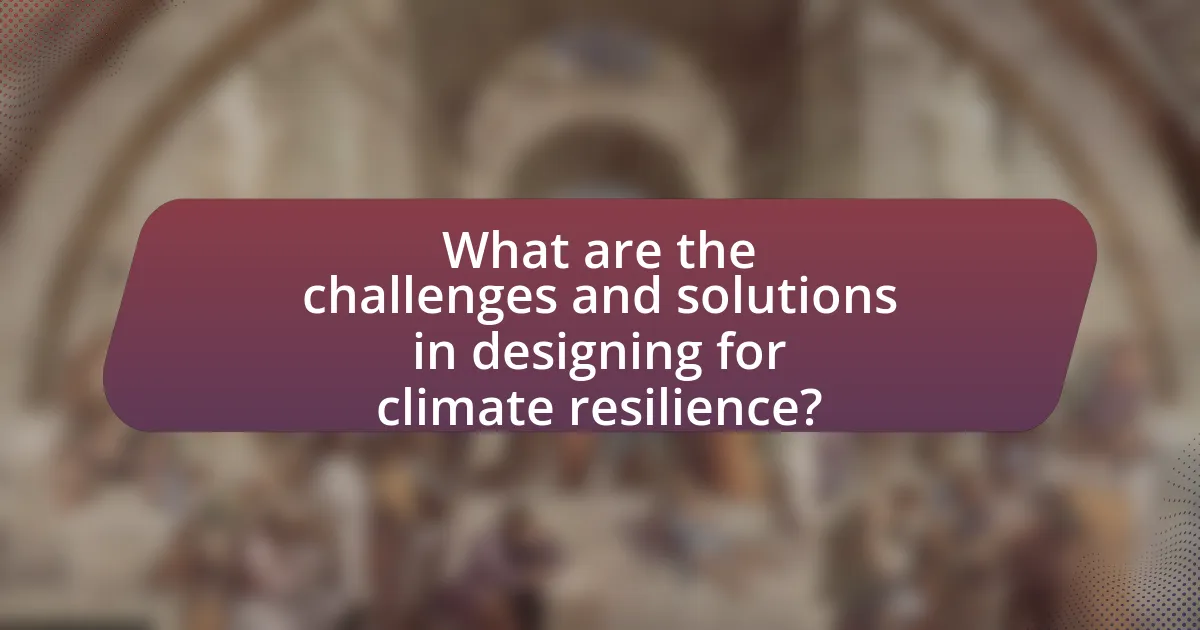
What are the challenges and solutions in designing for climate resilience?
Designing for climate resilience faces challenges such as increasing extreme weather events, rising sea levels, and resource scarcity. These challenges necessitate innovative solutions like adaptive building designs, the use of sustainable materials, and integrated water management systems. For instance, the National Oceanic and Atmospheric Administration (NOAA) reports that sea levels have risen by about 8 inches since 1880, prompting architects to incorporate elevated structures and flood-resistant designs. Additionally, the use of green roofs and permeable pavements can mitigate urban heat and manage stormwater effectively, demonstrating practical approaches to enhance resilience against climate impacts.
What common obstacles do architects face in implementing resilient designs?
Architects commonly face financial constraints, regulatory challenges, and a lack of stakeholder engagement when implementing resilient designs. Financial constraints often arise from the higher upfront costs associated with sustainable materials and technologies, which can deter clients from investing in resilient solutions. Regulatory challenges include navigating complex building codes and zoning laws that may not prioritize or incentivize resilience. Additionally, a lack of stakeholder engagement can hinder the integration of community needs and preferences, resulting in designs that do not fully address local vulnerabilities. These obstacles collectively impede the adoption of resilient architectural practices essential for adapting to climate change.
How can budget constraints affect climate-resilient projects?
Budget constraints can significantly limit the scope and effectiveness of climate-resilient projects. When funding is insufficient, project planners may have to compromise on essential features such as advanced materials, innovative technologies, or comprehensive risk assessments that enhance resilience against climate impacts. For instance, a study by the World Bank indicates that inadequate financing can lead to the implementation of lower-quality infrastructure, which may not withstand extreme weather events, ultimately increasing vulnerability and long-term costs.
What regulatory challenges exist for sustainable architecture?
Regulatory challenges for sustainable architecture include stringent building codes, zoning laws, and permitting processes that often prioritize traditional construction methods over innovative, eco-friendly designs. These regulations can hinder the adoption of sustainable materials and technologies, as they may not be explicitly recognized or supported within existing legal frameworks. For instance, many jurisdictions have outdated codes that do not accommodate renewable energy systems or green building practices, leading to delays and increased costs for projects aiming for sustainability. Additionally, the lack of standardized definitions for sustainability can create confusion and inconsistency in regulatory enforcement, further complicating compliance for architects and builders.
What best practices can architects follow for effective climate resilience?
Architects can enhance climate resilience by implementing strategies such as designing for passive solar heating, utilizing sustainable materials, and incorporating green infrastructure. Passive solar heating optimizes natural light and warmth, reducing energy consumption; studies show that buildings designed with this approach can decrease heating costs by up to 30%. Sustainable materials, like recycled or locally sourced products, minimize environmental impact and promote durability. Green infrastructure, including green roofs and permeable pavements, manages stormwater effectively, reducing flooding risks. These practices collectively contribute to buildings that withstand climate-related challenges, as evidenced by successful projects in regions prone to extreme weather events.
How can community engagement enhance design outcomes?
Community engagement enhances design outcomes by ensuring that the needs and preferences of the users are integrated into the design process. When architects and designers actively involve community members, they gain valuable insights that lead to more relevant and effective solutions. For instance, a study by the American Institute of Architects found that projects with community input are 30% more likely to meet the needs of the users, resulting in higher satisfaction and usability. Engaging the community also fosters a sense of ownership and responsibility, which can lead to better maintenance and longevity of the designed spaces.
What are the key principles of resilient architectural design?
The key principles of resilient architectural design include adaptability, sustainability, and risk mitigation. Adaptability ensures that structures can respond to changing environmental conditions, such as climate change and natural disasters. Sustainability focuses on using renewable resources and minimizing environmental impact, which is essential for long-term resilience. Risk mitigation involves assessing potential hazards and designing buildings to withstand them, thereby reducing vulnerability. These principles are supported by research indicating that resilient design can significantly lower repair costs and enhance safety during extreme weather events.
What practical steps can architects take to ensure climate resilience?
Architects can ensure climate resilience by integrating sustainable design principles, utilizing adaptive building materials, and implementing site-specific strategies. Sustainable design principles include maximizing energy efficiency through passive solar design, which can reduce energy consumption by up to 50% according to the U.S. Department of Energy. Adaptive building materials, such as those that are locally sourced or have low embodied energy, can minimize environmental impact and enhance durability against climate-related stresses. Additionally, site-specific strategies like elevating structures in flood-prone areas and incorporating green roofs can mitigate risks associated with extreme weather events. These steps collectively contribute to creating buildings that are not only environmentally responsible but also resilient to the impacts of climate change.
